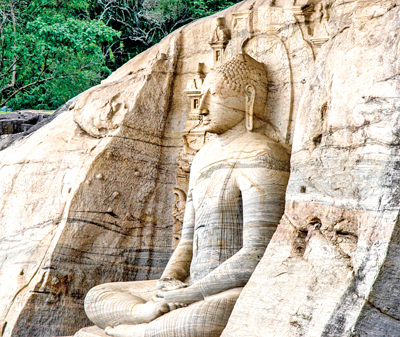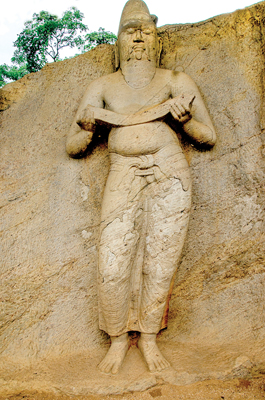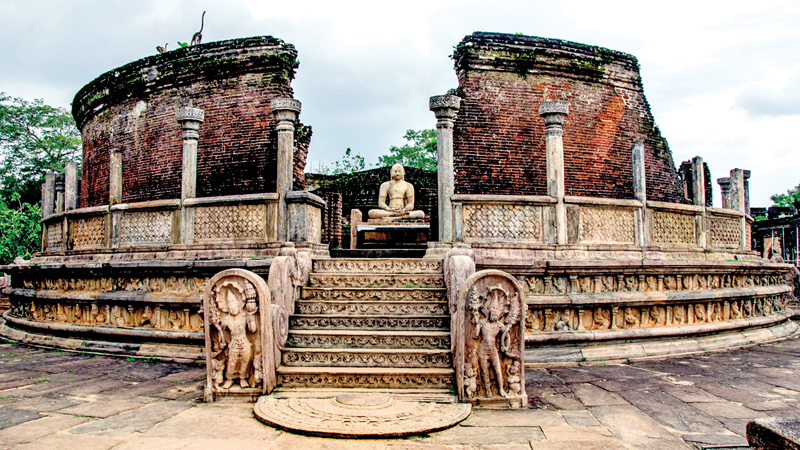 Visiting Polonnaruwa is the high point of any archaeological trip in the country. The number, variety and wealth of constructions are astonishing. Yet, what we discover today is nothing compared to the treasures listed in texts which constitute a fabulous inventory: some hundred Dagabas, about thirty temples, monasteries with a capacity to house six thousand bhikkhus and pilgrims, as well as a palace with a thousand rooms spread over seven floors.
Visiting Polonnaruwa is the high point of any archaeological trip in the country. The number, variety and wealth of constructions are astonishing. Yet, what we discover today is nothing compared to the treasures listed in texts which constitute a fabulous inventory: some hundred Dagabas, about thirty temples, monasteries with a capacity to house six thousand bhikkhus and pilgrims, as well as a palace with a thousand rooms spread over seven floors.
It is well-known that chroniclers tend to exaggerate. The former medieval capital at the time of its splendour was, without any doubt, an exceptional city. What we can see today, in spite of its ruined state, gives us a fairly precise idea of its magnificence.
The precise date when Polonnaruwa was founded is not known. The city has been successively called: Pulatthi, Pulastipura, ‘City of Pulasthi’, then Kalingapura in chronicles, where it is mentioned for the first time on the occasion of a donation given by King Aggabodhi III (626-641).

The seated Buddha statue at the Gal Vihara
It would seem, however, that the location has been occupied since the earliest days of antiquity. Situated in an area that is protected by a very dense forest, Polonnaruwa played the role of ‘refuge-capital’ during the numerous South Indian invasions of the 8th and 9th centuries. In addition, its geographic position, to the Southeast of Anuradhapura, facilitated access to the Southern province of Ruhuna.
When Rajarata, the island’s ancient kingdom, was wrested from South Indian Chola invaders at the close of the 11th century, Anuradhapura, its capital for 13 centuries, had been destroyed and abandoned. The Chola had ruled from Polonnaruwa, a backwater military outpost in the Anuradhapura heyday.
Polonnaruwa, however, had a more sheltered inland location. Its proximity to the Mahaweli ganga, a major trade artery, and to the great Trincomalee harbour, were other critical advantages.
Majestic metropolis
On routing the invaders, King Vijayabahu I established his capital too in Polonnaruwa. He, and the kings of the two-and-a-half centuries that followed, especially Parakramabahu the Great and Nissankamalla, made Polonnaruwa a majestic metropolis of grace and splendour, where agriculture, trade, commerce, learning, arts and crafts flourished and Buddhism was enthroned.
A custom-built and laid-out walled city, Polonnaruwa’s brick ramparts, moats, and gatehouses were no more civic ornamentations. They held the new capital fast and kept marauders at bay. Remains of the outer walls, which stretched along for 6km, and stood 3m high, can still be seen.
After securing the capital, Vijayabahu laid the foundations of Polonnaruwa’s glory. The kingdom’s vast, finely balanced irrigation systems were restored to rejuvenate agriculture, and the famed spice, pearl, and gem trades were revived.
Orthodox Buddhist monastic ordination and practice were restored. Among new shrines built was the Atadage, to enshrine the Sacred Tooth Relic of the Buddha, a handsome temple of chaste and elegant style, as its remains show.

The statue of King Parakramabahu I
Polonnaruwa plunged into turmoil on Vijayabahu’s death, but its fortunes held. Another great king, Parakramabahu I, emerged, to take it into a golden age.
Polonnaruwa is largely Parakramabahu’s city. Its walls and fortifications to be seen today are his. The many magnificent edifices with which he adorned the capital precipitated a spectacular renaissance of architecture, sculpture, and art, making Sri Lanka’s mediaeval capital one of the grandest cities of the age. Among these are the royal palace with 2m-thick walls; excavations have revealed a landscaped complex of outbuildings, gardens, ponds and baths.
Nearby, the Royal Council Chamber is a stately pavilion set on a three-tiered stone platform, decorated with splendid bas-reliefs and rampant guardian dragons. The three-tiered Royal Bath is by contrast of a plain geometric design. The Nandana Uyana which surrounds it was, according to a historical chronical of the period, an exquisite pleasure garden of jasmine bowers, orchards abuzz with nectar-drunk honey bees, peacock pavilions, and a hall of mirrors.
Monastic university
Parakramabahu endowed Polonnaruwa with the Alahana Parivena, a monastic university set on a landscaped hill of platforms and terraces. A UNESCO World Heritage site, excavations have revealed monastic dwellings, pavilions and ponds of austere and classic lines and a hospital, where surgical instruments and a stone medicine trough for body immersion in herbal solutions have been found.
The complex includes a chapter house with a convocation hall and abbot’s seat, and the Lankathilake Image House of towering columns. Nearby is the Lotus Bath of four concentric tiers of eight-petalled lotuses cut out of granite and meant not for fastidious queens and princesses but exclusively for bhikkhus.
The sublime Gal Vihara is a stunning tableau of three magnificent Buddha images in seated, standing, and reclining poses, carved nearly in the round from a huge rock face, with fluid grace and almost live expression. The seated figure is 5m high; the standing and recumbent images measure 7m and 14m.
When its civilisation flourished and culture flowered, a superb irrigation system nourished agriculture to make the Polonnaruwa era plentiful and prosperous. Here, Parakramabahu’s feats were epic. The vast scenic Parakrama Samudra (Sea of Parakrama), was the centrepiece of the capital, its life-blood, and is still in everyday use. Parakramabahu also constructed and repaired thousands of other irrigation works of varying sizes; not surprisingly, rice was exported at this time. An august, rock-cut sculpture gazing at his great reservoir is thought to be of the king.
International trade, commenced, and diplomacy prospered and Polonnaruwa became a glittering magnet for important foreign personages. Crafts such as metalwork, jewellery, pottery, and coinage thrived. Fine bronze images, Chinese porcelain, pottery, and Sung dynasty and other coins of the period are exhibited at the Polonnaruwa site museum and the Colombo National Museum.
Graceful Vatadage
Nissankamalla, the last of Polonnaruwa’s prominent monarchs (1187-1191 AD), embellished his capital with edifices such as the graceful Vatadage of slender pillars, fret-worked stone friezes and ornate guard stones. The building is girded with a circle of stone pillars; at each of the cardinal points is a moonstone set in the ground, carved with elephant and lions; from each stone, a flight of stairs leads to a seated figure of the Buddha. In Nissankamalla’s day, it must have been the most beautiful building in Sri Lanka.
The whimsical Nissanka Latha Mandapaya, whose stone columns simulate long-stemmed lotuses is a centre of attraction. His Council Chamber and Audience Hall are impressively regal and the 8x4m Gal Potha is a huge stone book inscribed with his grate deeds.
Polonnaruwa’s Rankoth Vehera was built by Nissankamalla and it has been built according to the tradition of the stupas of the Anuradhapura Maha Vihara and bears a close resemblance to Ruwanwelisaya. In fact, a stone inscription close to the stupa even identifies it by the name ‘Ruwanweli’. However, it has later come to be known by the currently used name, Rankoth Vehera. In Sinhala, ‘ran’ means gold, ‘kotha’ is the name given to the pinnacle of a stupa, and vehera means stupa or temple. Thus, the name Rankoth Vehera can be roughly translated to English as ‘Gold Pinnacled Stupa’. Along with the Kiri Vehera, it is one of the most revered stupas in Polonnaruwa.
At the foot of this quadrilateral of Buddhist sanctuaries is a 13th century Siva Devale, a vestige of the Pandyan occupation. Many of the magnificent Hindu bronze exhibited in the Colombo National Museum were found in this temple. In Polonnaruwa, there are 12 or so Hindu temples the most interesting being the Siva Devale 1 and Siva Devale 2. At the Siva Devale, a headless Nandi bull guards the entrance to an inner sanctum where a lingam (stone phallus) stands garlanded by flowers.
Intermittent invasion forced the abandonment of Polonnaruwa in the closing years of the 13th century, when Dambadeniya emerged to take its place.






